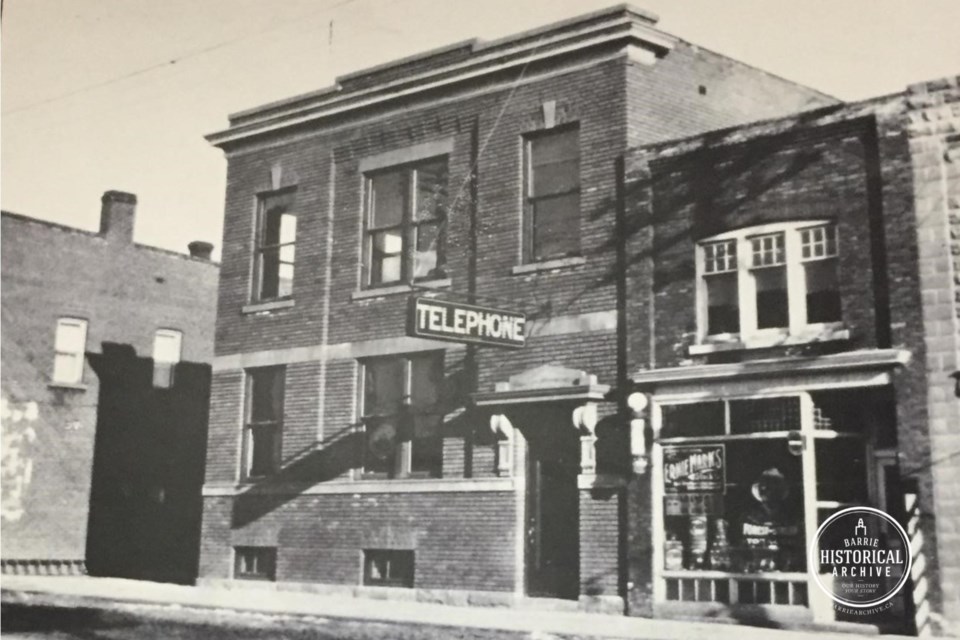This ongoing series from Barrie Historical Archive curator Deb Exel shows old photos from the collection and one from the present day, as well as the story behind them. For more on Barrie and the Bell Telephone Co., also be sure to check out Saturday's Remember This column from Mary Harris, which can be found by clicking here.
The Bell Telephone Company
In this week of Alexander Graham Bell’s birthday (March 3, 1847), you are a getting a heapin’ helping of telephone history.
It was actually 144 years ago today, on March 7, 1877, that Alexander Graham Bell received his Canadian patent for the Bell telephone. He promptly transferred 75 per cent of the business to his dad to start up a telephone business in Canada. The Bell Telephone Company of Canada was incorporated in April 1880.
The arrival of the telephone in Barrie was a big deal around the county. In March 1885, a news item read: “Beeton wants telephone communication with Barrie. Every go-ahead place wants connection with a town of life and intelligence.”
Someone must have been listening as a news item on July 23 of the same year subsequently reported: “Six car loads of telephone poles were unloaded at Beeton today.”
Many, many towns and villages across Ontario had their own independent telephone companies — also known as 'telcos' — in the early days. But many of these rural communities did not set up their telephone service until the early 1900s. … The farmers and villagers remained isolated from easy and crucial communication with family, businesses, the doctor or veterinarian, unlike folks in town.
Minesing’s first phone — a toll line — was installed in Ronald’s General Store in 1905, allowing villagers to call long distance. The first line installed was from the store across the road to Mr. Ronald’s father’s house about 1906. Each ‘line’ had its own subscribers: Line 1 had five subscribers when it was built about 1907. Line 6, built with volunteer labour in 1910, had nine subscribers, each contributing five poles and $2.65 for wire.
By about 1918, the Minesing Telephone system had 114 subscribers, later incorporating in 1923 to become the owner of all the lines, equipment and subscribers. All of these individual lines required upkeep, and with a rate hike to $13 per year to support it, the maintenance and repair job went to Fred Parry. Like many small telcos, Minesing later sold their company in 1961 to Bell Telephone, who took over in 1964.
The Ivy-Thornton Telephone Company formed in 1909 with 48 subscribers, connecting the villages of Ivy, Thornton, Egbert and Utopia. They had no connection to the Bell network until they built a line to Holly, which linked them to the Bell Telephone Company in Barrie.
The Vespra Municipal Telephone System was established in 1913. They contracted their switching to the Bell Telephone Company in Barrie and once the initial construction was complete, there were 108 subscribers, 39 miles of poles and 72 miles of two-wire circuit. By 1930, there were 200 phone lines in Vespra.
Stroud started building its network in 1911. Ten miles of lines on the 9th and 10th concessions connected to the Central Office of the Stroud Telephone system. Prior to that, Stroud did not have a connection to the Bell Telephone Company in Barrie. However, Bell did have a pair of wires (with five telephones) to Craigvale, and when the Stroud Telephone Company purchased them in 1912, they finally had their connection to Barrie.
By 1930, the Stroud Telephone Company had about 260 subscribers in the northeast part of Innisfil Township, including service to summer cottagers along Lake Simcoe.
The Barrie-Angus Telephone Company organized in 1915 to serve the village of Angus, Utopia and the area north of Angus. They also used the Barrie Bell Telephone Company for their switching, so they had continuous service day and night, including Sundays!
In 1905, five farmers on Ridge Road — between Shanty Bay and Hawkestone — got together and built a telephone line for their own use, hoping to connect with Bell Telephone in Barrie. They got their wish in 1909 when the Oro Independent Telephone Company incorporated and they set up their Central Office (switchboard) in Shanty Bay.
They moved their switchboard twice to be more centralized: first to Mitchell Square, then to Oro Station. By 1930, the system of five subscribers had grown to about 300 phones.
It’s easy to understand, given the effort and expense to string wires between points, why party lines existed to share these connections! And why contracting the ‘switching’ to Bell Telephone meant someone was there around the clock to put calls through.
The Bell Telephone office on Elizabeth Street (now Dunlop Street West), looks the same – but different – from the early 1900's. The original entrance was once on the west end of the building, closest to where Kerry’s Book Store is today.
Sidebar: In 1909, the Bell Telephone Company of Canada purchased its first motorized vehicle, which was built by the Tudhope Carriage Company in Orillia.
At the beginning of the First World War, the Bell Telephone Company committed to rehiring all permanent employees who had enlisted in the armed forces. By the end of 1918, of the 833 Bell employees who had served abroad, miraculously, all but 79 returned.
During the war, the Barrie Bell office had a job – a job they hoped they’d never get. In the event of a catastrophe elsewhere, the Barrie office had trained employees who would be responsible for sending ham radio messages and, to that end, a bomb shelter was located in the basement of the building. It included a communications centre, complete with beds and other survival necessities… just in case.
Around 1929, the structure was expanding onto the vacant lot next to the telephone building and the entrance was moved to the east end of the offices, where it is today.
In 1946, the town approved a permit to add a third storey to accommodate more switching equipment to meet the demand for phone lines.
In 1955, two major extensions were added to the downtown location. This expansion facilitated the new telephone numbering plan that rolled out the following summer called the Parkway exchange. The PA (PArkway) exchange would precede either a ‘6’ or an ‘8’, followed by the current four digits of the phone number. The PA, of course, represented ‘7’ and ‘2’, and eventually, all seven digits would need to be dialled.
The first public telephone was introduced in 1881 and in 1947, town council gave Bell permission to install the first outdoor telephone at the corner of Maple Avenue and Elizabeth Street (now Dunlop Street West). Some of you may recall when the payphone at the northeast corner of this intersection was removed – it may have been just about the last of payphones downtown!
The Bell Telephone Company built a very modern new Central Office at 140 Bayfield St., in 1964. The Bell Telephone Company invited the community to tour the new facilities and enjoy displays of futurist innovations like Laser (fibre optics) and the Shmoo Phone (nicknamed because its handset resembled a character in the Lil' Abner comic strip). As exciting as the new telephone frontier appeared in 1964, it would still be decades before those two humble copper telephone wires into our homes would be delivering cool stuff like the internet or TV.
The old telephone building on Dunlop Street continued to be used for Bell Canada offices until it was sold. It is now apartments.







